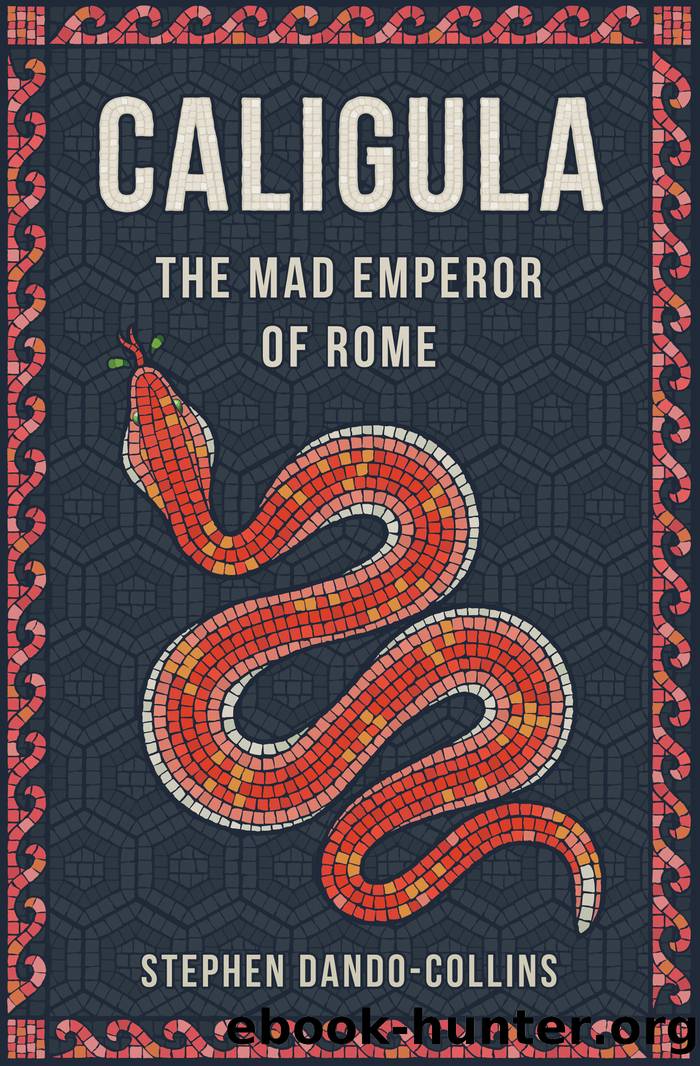Caligula by Stephen Dando-Collins;

Author:Stephen Dando-Collins;
Language: eng
Format: epub
Publisher: Lightning Source Inc. (Tier 1)
Published: 2019-10-15T00:00:00+00:00
XIX
SHOCKS IN GAUL
Shortly after September 19, AD 39, following the five days of chariot racing that culminated the long program of the Great Games, the emperor moved to the suburbs of Rome, leaving the new consuls Afer and Gallus in charge at the capital. Itâs highly likely that his partyânow in the suburbs with Caligulaâincluded his wife and two sisters, King Agrippa and King Antiochus of Commagene, the emperorâs brothers-in-law Lepidus and Vinicius, and a clutch of senators including Galba. They would have been joined by a Praetorian prefect and the commander of the German Guard, as well as senior Palatium staff.
Josephus tells us that when Agrippa returned to Rome that year to rejoin Caligulaâs court, he remembered an old promise and purchased the freedom of Caligulaâs slave Thaumustus. This was the same slave whoâd given him water when he was being taken away in chains from Tiberiusâs villa at Tusculum three years earlier. Agrippa subsequently sent Thaumustus to the Middle East to manage his estates there. Thaumustus would serve Agrippa until the kingâs death, after which he faithfully served Agrippaâs son and daughter.169
Soon after leaving the city proper, the emperor, his courtiers, and a massive entourage including actors and gladiators, departed Italy unannounced. Suetonius thought it scandalous that actors, gladiators, women, and horses were in the imperial party, but all had their role to play in what was to follow. The gladiators in question would have been the twenty Thracians of Caligulaâs personal troupe, whom he would pit against all comers at games in Gaul, most particularly at Lugdunum, todayâs Lyon in central France, where he planned to spend the winter. The actors, too, would appear at the games, in theatrical shows.
By far the largest contingent in the imperial party was made up of troopsâcohorts of his German Guard bodyguard and several cohorts of the Praetorian Guard, plus the men and horses from an ala (wing) or two of the Praetorian Horse. Perhaps as much as half the now enlarged Praetorian Guardâsix thousand menâwas heading north. In all, the emperorâs escort is likely to have involved more than ten thousand troops. The entourage would also have included hundreds, if not thousands, of servants of the emperor and his courtiersâdoctors, secretaries, cooks, bakers, stewards, valets, dressers, hairdressers, and handmaids. In the imperial court, there were even slaves whose only job was to maintain the water clocks, while others collected cobwebs as a remedy against the emperorâs shaving cuts.
Caligulaâs route and mode of transport for reaching Gaul was not recorded by the ancient authorities, but modern scholars have tended to assume that Caligula and his party traveled overland all the way, through northern Italy to the south of France. However, we know that during his reign Caligula had the habit of using ships of the war fleet based close to Rome at Misenum. Plus, itâs recorded that when the next emperor made this exact same trip to Gaul with a similarly large party not many years later, he traveled by sea from Ostia, port of Rome, to the port of Massalia in Narbonne Gaul, todayâs Marseille.
Download
This site does not store any files on its server. We only index and link to content provided by other sites. Please contact the content providers to delete copyright contents if any and email us, we'll remove relevant links or contents immediately.
The Secret History by Donna Tartt(18694)
The Social Justice Warrior Handbook by Lisa De Pasquale(12069)
Thirteen Reasons Why by Jay Asher(8716)
This Is How You Lose Her by Junot Diaz(6689)
Weapons of Math Destruction by Cathy O'Neil(6068)
Zero to One by Peter Thiel(5618)
Beartown by Fredrik Backman(5533)
The Myth of the Strong Leader by Archie Brown(5358)
The Fire Next Time by James Baldwin(5185)
How Democracies Die by Steven Levitsky & Daniel Ziblatt(5083)
Promise Me, Dad by Joe Biden(5029)
Stone's Rules by Roger Stone(4981)
100 Deadly Skills by Clint Emerson(4785)
A Higher Loyalty: Truth, Lies, and Leadership by James Comey(4768)
Rise and Kill First by Ronen Bergman(4643)
Secrecy World by Jake Bernstein(4584)
The David Icke Guide to the Global Conspiracy (and how to end it) by David Icke(4539)
The Farm by Tom Rob Smith(4397)
The Doomsday Machine by Daniel Ellsberg(4366)
